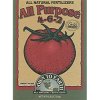To cook your soil, you need to add amendments. Your base mix though should have been 1/3,1/3,1/3.
i really have come to dislike the term "cook"; there is no "cooking" involved.
What we're doing is
inoculating our pile with organisms, giving them a food source, and they're creating a stable environment for the plant, themselves, and the soil biota.
@ShLUbY the all purpose 5-5-5 you speak of, is the purpose of adding that mostly for seedlings? or just generally to add it in the mix(even though we will have say 18 Phosphrous from bone meal)
Im wondering why people seem to add ingredients which overlap big time in the NPK ratios..., I was thinking to source one ingredient for each NPK and leave it at that - bad idea?
You guys are lucky in the states, Im having difficulity sourcing common ingredients like Seabird Guano, granite meal, good fish blood, etc...
no, actually seedlings should just be started in a mix of basically what your original post was: peat

erlite:compost/EWC, of equal portions 1:1:1. nothing more is needed to have healthy seed starts. hell even just peat/perlite equal parts is good to start seeds, but the EWC/Compost just adds a good touch of very low nutrients for the seedlings, as they don't require much food at all (its stored with them from seed).
when saying "all purpose" it's a complete nutrient blend of all macro and micronutrients and would be suitable for most all stages of growth. you can get a "vegetative growth" blend that is slightly higher in N than P or K, or you can get a "bloom growth" that is slightly lower in N than P or K for flower production.
you are fine to get a different product for each of the NPKs, however one must note that those numbers are a % of the total weight of the package. so for an easy example, if you have 10lbs of 10-10-10 fert, that is saying 10% 10% 10% by weight, so you have 1lb of N, 1lb of P, and 1lb of K.... not to mention all the minerals and micronutrients that may be contained in the package as well. so when you are blending nutrients together, it's important to mix them by weight ratios rather than going by just the numbers alone. for example, Kelp is 0-0-1 and weighs basically nothing... so 1% K by weight.... at the given application of generally 1/2 cup per cuft of soil... how much K do you think that product is really adding? Minimal is the answer. Kelp is far more useful for its enzymes, minerals, vitamins, and other benefits than it is for a flowering product. I'm not trying to put kelp down, it's a staple in my soil recipe, i'm just giving a clear example. on that same subject, the greensand i use is 0-0-7, and it's a heavy 1/2 cup of amendments, so 7% of something heavy is actually a substantial K source and since introducing it to my mix i've seen the results i realized that the coots recipe was missing.
also when blending products, you need to be SURE that you are getting all the micronutrients: your Boron, manganese, magnesium, Iron, etc....
good luck sourcing your products, and i hope that little ramble helps you figure out what you need.


